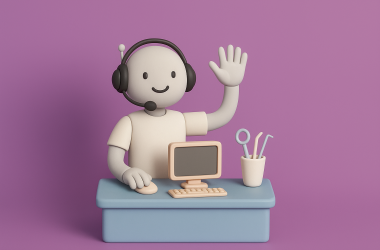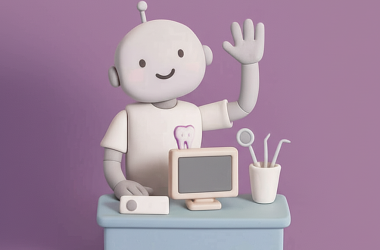Customers don’t care if it’s after hours. They care if you answer.
Whether it’s 11:47 PM or 6:00 AM, when a potential client calls your business,
You’ve got a tiny window to make a solid first impression (or lose them for good).
That’s where a 24-hour virtual receptionist becomes your secret weapon.
It’s not just about picking up the phone. It’s about greeting every caller like your #1 priority, solving their needs instantly, and never missing a lead because “no one was around.”
In this guide, we’ll break down how 24/7 virtual receptionists work, which industries benefit the most, and why businesses are swapping voicemails for AI virtual assistants that close deals while you sleep.
What Is a 24-Hour Virtual Receptionist?
A 24/7 virtual receptionist is your front desk that never clocks out.
It handles inbound calls, qualifies leads, books appointments, answers FAQs, and passes complex issues to your team.Whether it’s a customer with a burst pipe at midnight or a new homeowner asking for a quote on Sunday morning, your receptionist is there to answer, help, and close.
And unlike a full-time hire, it won’t run you $4K/month (plus training, benefits, and turnover headaches). Best of all? You don’t pay overtime.
How Does a 24/7 Virtual Receptionist Work?
Here’s how it works behind the scenes:
1. Inbound Call or Message – The customer calls your business, sends a message, and your receptionist picks it up instantly.
2. AI or Human Response – Depending on your setup, either a trained AI answers with your brand’s voice, pricing and services. Or routes the call to a live agent.
3. Intent Recognition & Task Handling – The system figures out what the caller needs, whether that’s a question (“Do you fix gas heaters?”) or a request (“I need someone to take a look at the kitchen sink”), the system handles the task.
4. Real-Time Action – The AI virtual receptionist checks your business’s synced calendar and/or scheduling system to confirm real-time availability. Then, schedule an appointment with the customer and sends a follow-up SMS/email confirmation, ALL whilst logging the interaction in your CRM or scheduling system.
5. Escalation When Needed – If the caller is upset, confused, or has a request outside the AI’s scope, it routes them to your team seamlessly, without making the customer repeat themselves again and again.
6. Post-Call Summaries – After the call, your team receives summaries and transcripts with action items logged. Every interaction is logged. No call is lost.
Key Features to Look For in a Virtual Receptionist Service
If you’re going to trust your brand’s first impression to an automated system, it better be built right. Look for:
1. 24/7 Availabiliity – Whether it’s a Saturday night or a holiday Monday, your receptionist needs to pick up. That means no missed leads, ever—and no more checking voicemails during dinner.
2. Real People Energy (Even If It’s AI) – It should sound like a human, speak in your tone, and carry your brand’s vibe. If it feels like talking to a soulless bot, customers are gone before you hit “return call.”
3. On-the-Phone Appointment Scheduling – Book jobs while customers are still on the line. No callbacks. No delays. Fewer drop-offs.
4. Answers With Authority – Your receptionist should know your business. FAQs, service areas, pricing—trained in and ready to go, so customers get the answers they need without the runaround.
5. Escalating when it should – Urgent call? Complex customer? Emotional situation? Not every call can be handled by a script. A solid virtual receptionist knows when to hand the call over, without the customer being looped in a circle of questions and being frustrated.
6. Tech Integration – Works With Your Tools, Not Against Them. Connects to your CRM, calendar, dispatch, and VOIP tools. Zero manual entry. Maximum efficiency. No extra admin work.
7. Call Summaries & Transcripts – Every interaction is logged and summarised. So even if you didn’t take the call, you’re never out of the loop.
Industries That Benefit Most from 24/7 Virtual Receptionists
If your customers can’t wait until 9 AM… this service is for you.
Home Services (HVAC, Plumbing, Roofing, Electrical)
Emergencies don’t wait. An AI receptionist can take after-hours calls, book jobs, and escalate true crises to your on-call tech, so you win more high-value emergency jobs.
Legal
Whether it’s a DUI arrest or landlord dispute, people seek legal help at all hours. A virtual receptionist can intake leads, ask qualifying questions, and book consultations while your paralegals sleep.
Healthcare & Wellness
Physio, Psychologist, Chiropractor… or any form of service-based healthcare & wellness business, a 24/7 receptionist helps book appointments, cancel/reschedule, or send follow-ups without tying up front desk staff.
Real Estate
Property inquiries often come in late at night. A virtual receptionist can capture leads, book showings, and answer listing questions when agents aren’t available.
Insurance & Finance
From claims to coverage questions to new account inquiries, you’ll never leave high-value clients waiting on hold again.
Benefits of Using a 24-Hour Virtual Receptionist
Capture Every Lead
No more missed calls, voicemail graveyards, or “we’ll call you back” disasters. Every inquiry is answered in real-time, increasing your conversion rate and reducing lead leakage.
Book More Jobs Automatically
Instant scheduling leads to faster decisions. When your AI books jobs while customers are still on the call, you cut the drop-off rate and outpace your competitors.
Reduce Labour Costs
Hiring a full-time receptionist can cost $4,000+/mo. AI virtual receptionists handle hundreds of calls at a fraction of the cost—no sick days, no training, no HR overhead.
Faster Response Times
75% of customers say fast response time is the top sign of good service. AI answers immediately—no hold music, no “please wait.”
Scales Without Hiring
Got more locations? A surge in calls? Your AI scales automatically—no desks, no interviews, no onboarding required.
24/7 AI Receptionist vs. Live Virtual Assistant: What’s Right for You?
| Legal, medical, and personal services | AI Receptionist | Live Virtual Assistant |
| Availability | 24/7/365 | Limited by human shift hours |
| Cost | Low fixed cost | Hourly or per-call rates |
| Speed | Instant answers & bookings | Slight delay based on call flow |
| Emotional Intelligence | Moderate (based on training) | High |
| Best Use Case | Home services, high-volume calls | Legal, medical, personal services |
| Scalability | Extremely scalable | Requires more agents |
Pro tip: The best systems use both. Let AI handle 80% of routine calls and route complex/emotional cases to a live agent.
Best Practices to Maximise ROI from 24/7 Receptionists
A virtual receptionist isn’t just a glorified answering machine; it’s the face of your business.
To get real returns, you’ve got to set it up like a top-performing team member.
1. Train It Like a New Hire (Because It Kind of Is)
Upload as much information about your business as possible with things such as: service guides, pricing breakdowns, FAQs, SOPs, and company-specific terminology. The more context it has, the more precise its answer can be on calls and the fewer escalations your human team will need to handle.
2. Define Escalation Logic Clearly
Not every call needs an esclation to a human rep, but some absolutely do. Define what qualifies as urgent (emergencies, VIP clients, emotional customers), and create fast, frictionless handoff rules to a real person. If done right, this step can prevent a large percentage of churn and turn frustrated callers into loyal customers.
3. Monitor Call Summaries & Transcripts
Take some time regularly to go through the summaries logged. These provide insight into what customers are asking for that your receptionist can’t yet answer. Use these insights to refine scripts, update training data, or even adjust your overall offer.
4. Integrate It with Your Entire Workflow
Don’t make your staff members bounce around. Make sure your receptionist syncs with your CRM (for lead tracking), calendar (for real-time booking), VOIP (for call handling), and dispatch platform (for job routing). Full integration means no double entry, no missed handoffs, and a smoother customer journey.
5. Treat It Like a Revenue Tool—Not a Cost Center
Your virtual receptionist should be capturing leads, booking jobs, and protecting your reputation. Set KPIs around missed calls, booking rates, and escalation frequency. Then track performance like you would any high-performing sales or service role.
Why Choose ServiceAgent for 24/7 Virtual Receptionist Services?
ServiceAgent.AI doesn’t just answer phones—it acts like your most trained, consistent, and scalable team member.
Built on 1 Billion+ Real Calls
Trained using real industry-specific calls (especially in home services), so it understands your customers and speaks their language.
A Voice That Builds Trust
Choose a tone and name that fits your brand. AI sounds like someone your customers want to talk to.
Real-Time Booking
No “we’ll call you back.” It books appointments during the call, confirms via SMS/email, and updates your calendar instantly.
Smart Escalation Built-In
Whether it’s an upset caller or a high-value lead, ServiceAgent knows when to escalate—without loops or repeat info.
Easy Setup
Go live in under 30 minutes. No developer. No long onboarding. Just switch it on and start answering.
Integrates With Your Systems
From VOIP to dispatch to CRMs like HubSpot or ServiceTitan, it plugs right in—so your ops stay tight.
Focused on Results
This isn’t just about answering more calls. It’s about closing more of them. More jobs, more revenue, less overhead.
FAQs
Q: Is ServiceAgent fully AI?
Yes, it’s AI-first—but built to escalate to humans when needed.
Q: Will it sound robotic?
No. You choose the tone and voice. It sounds like a member of your team.
Q: Can it book appointments?
Absolutely. It checks real-time availability, books jobs, and sends confirmations.
Q: How long does setup take?
You’ll be live in under 30 minutes. No dev team needed.
Q: Can I change scripts later?
Yes. You can update anything—scripts, escalation rules, service info—using simple plain English.

